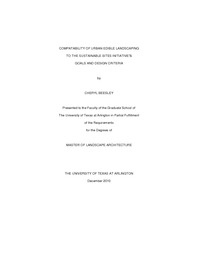| dc.description.abstract | This research addresses edible landscapes through the lens of The Sustainable Sites Initiative (SITES). The Sustainable Sites Initiative is a collaboration of the American Society of Landscape Architects (ASLA), The Ladybird Johnson Wildlife Center and the United States Botanic Garden. The team of professionals working on SITES has developed a manual for sustainable site development and landscaping practice that include guidelines regarding site development, installation, and maintenance practices. Various levels of certification can be obtained by accumulating points in categories that relate to new site construction or site renovation. It is the purpose of this thesis to research how urban edible landscaping may or may not fit into the SITES point criteria. The Sustainable Sites Initiative includes criteria for sustainable site development in the areas of water conservation, fuel conservation, lessening toxic pollutants entering water, soil and air, and conservation of existing topsoil. Most of these criteria are affected to some degree by edible landscaping in urban areas. This thesis uses three methods to evaluate the compatibility of urban edible landscaping for SITES point criteria. First, SITES guidelines are analyzed to determine if there are any direct conflicts regarding edible urban landscapes. Secondly, interviews with design professionals who have been associated with the development of the SITES Guidelines and Benchmarks are compared and analyzed for common thoughts and opinions regarding compatibility of edible landscapes with SITES certification. Finally, a case study of The Olive Tree Learning Center, an edible landscape in Austin, Texas, is evaluated for compatibility and possible point accumulation using the criteria of the Sustainable Sites Initiative Benchmarks and Guidelines, 2009. Evaluation of the interviews, SITES' criteria and the application of this evaluation to the Olive Tree Learning Center reveals no direct conflict with edible landscapes and the SITES prerequisites and credits; however, certain credits are more well-suited for point accumulation. Charts that rate probable point accumulations are for each section of SITES are in located in Chapter 5. These point accumulations are based on the research in this study; however, they are subjective, and will vary widely from site to site according to a particular site's variables regarding site selection, construction and maintenance. | en_US |

